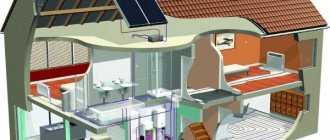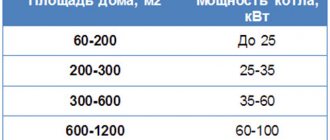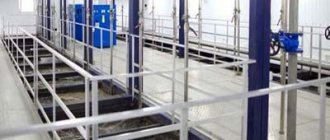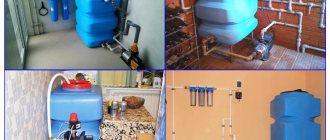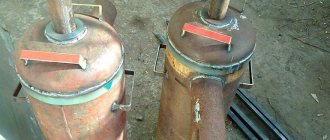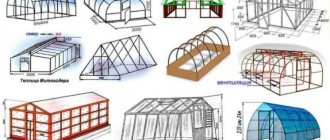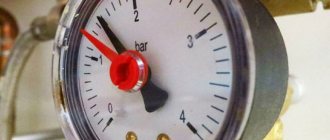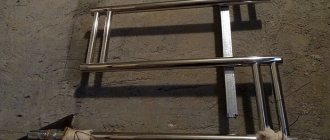Any heating scheme in a private house consists of components: a heat generator; a boiler; current diagram of the heating system of a private house, including fittings and equipment; control and heating devices. Installation of main risers and connections to heating radiators. All rules for installing boilers are described in detail in the instructions for them. Heating a private house with electricity
The heat source can be: air heaters; heat guns; thermal curtains. Please comment on the post and participate in discussions.
Installation work is carried out according to the following scheme: Installation of an electric heating boiler. The most expensive wiring method: pipelines from the collector are laid separately to each radiator, the installation method is hidden, in the floor.
The connection diagram may be different.
The latter option is preferable, as it allows you to more accurately regulate the microclimate in the house. The movement of water occurs in counter directions.
Do-it-yourself heating of a private house: installation diagrams and rules It is difficult to imagine a modern home without a heating system.
Heating using an electric boiler "Protherm"
Types of electric heating
Today, electric heating systems are represented by a wide variety of equipment through which private households are heated.
The main types of such heating are presented:
- electric boilers of various modifications;
- electric convectors;
- electric heat fans;
- traditional oil heating radiators;
- infrared long-wave heating devices;
- electric "warm floor" system.
Thus, the type of heating system can be air, water and steam, or the “warm floor” option. Any of the listed types has certain advantages, but is also not without some disadvantages, which must be taken into account in the process of designing a heating system.
Heating a private home with electricity can be done in various ways, but regardless of the option, the cost-effectiveness of using the system largely depends on the level of insulation of the home.
Why electricity
The cheapest heat source is mains gas. For the owner of a gas boiler, a kilowatt-hour of heat costs only 50-70 kopecks. The only problem is that in many villages and suburbs of our great and vast land there is simply no gas.
Following gas in terms of cheapness of energy are:
- Firewood with a result of 0.9-1.1 rubles/kWh;
If there is no main gas, it is cheaper to heat the house with wood.
- Pellets (granulated sawdust) - 1.4-1.5 rubles/kWh;
- Hard coal - 1.6 rubles/kWh.
And how can electric heating, which costs 3-5 times more, compete with them?
Comrades, the list of key properties of a heating system does not end with efficiency. Autonomy is also important for her - the ability to maintain a constant and comfortable temperature in the house without the participation of the owner. And according to this parameter, solid fuel loses to electricity to smithereens:
- Classic solid fuel boilers need to be loaded with fuel and kindled every 3-6 hours;
The disadvantage of solid fuel heating is that the boiler needs to be lit every few hours.
- Pyrolysis boilers lengthen the interval between kindlings to 10-12 hours;
- Pellet boilers with automated fuel supply from the bunker operate autonomously for up to a week;
Pellet boiler with automatic fuel supply. Autonomy is limited only by the size of the bunker.
- All types of electric heating at home can operate without care and maintenance indefinitely.
Checkmate. Heating that does not allow you to leave the house for several days without resetting and draining the heating circuit (otherwise it will be defrosted) is extremely inconvenient.
A pellet boiler will be able to keep the house warm during your absence for several days. But constant supplies of pellets are not available everywhere, and the variation in prices for them often calls into question the efficiency of this type of fuel. Let's say, in Moscow a ton of pellets costs 7,000 rubles, and in Sevastopol - from 15,000.
Prices for pellets vary depending on the distance from the manufacturer and the number of competing offers.
So, our task is to find ways to reduce the overhead costs of heating with electricity.
Electric heating of a private house: diagrams
You can independently perform electric heating of a private home that is as convenient to operate and maintain as possible, efficient, and also affordable, only if you follow a competent connection diagram for such a system:
- To implement the installation scheme for a boiler with a heat accumulator, it is necessary to use a two-rate tariff for electrical energy and install a two-tariff meter. The scheme also involves the construction of a small circuit with forced circulation of a coolant to connect an electric boiler with a heat accumulator, and a large circuit encircling the house and connecting the tank to the radiators.
- The “warm floor” heating system can be implemented in different ways, including installing a pipeline with a thermal fluid, laying a heating cable or installing film heaters.
- The use of an infrared heating circuit allows you to obtain heating by convection or thermal radiation using devices that have a ceramic or glass heating panel, quartz tube, metal or film surface.
Electric heating scheme
Less common options for electric heating of private households are the use of air conditioners and special heat pump equipment.
Electric heating can become a fairly economical option, quite successfully competing with solid fuel and gas equipment only with the right choice of heating devices.
Electrode devices
A better alternative to water heating heating elements, which involves the use of electricity for heating, can be called electrode-type boilers. Such a device is a small container containing electrodes. When the boiler is filled with water, current will begin to flow to these electrodes, and this, in turn, will cause the water to heat up.
In order for the electrode boiler to work as efficiently as possible, the coolant will need to be subjected to special preparation. An electrode boiler consumes more electricity than a heating element type boiler. However, it is more reliable and does not fail as often.
Features of the heated floor system
All types of electric heated floors operate on a 220 volt network. The temperature regime on the floor surface is as comfortable as possible, which is due to the transfer of thermal energy from heated cable conductors or through infrared radiation. The most important advantage of such a system is simple operation and accessible control.
From the temperature sensor, information is transmitted to a modern thermostat. This is a multifunctional device through which the “warm floor” system is connected to the electrical network and the heating level is controlled.
Electrical connection diagram for infrared heated floor
Traditional modifications of the system, depending on the type of heating element, can be represented by cable, film and rod “warm floor” structures.
It is very important to understand that the electric heating system of a private house “warm floor” is a kind of multi-layer cake, therefore, to obtain effective heating it is very important to correctly direct the thermal energy.
Electric convectors and their varieties
Electric convectors and their varieties
No less popular units for electrical heating of a private home are convectors with their many modifications in the form of thermal curtains, “guns” and fan heaters.
Thermal curtains are not used in residential premises. They are usually placed above doorways. When the door is opened, the curtain automatically turns on and prevents cold air from entering the room.
To install, simply mount the device above the doorway and connect it to the network. Depending on the characteristics of a particular design, the order of its connection may have individual characteristics. Therefore, be sure to carefully study the instructions for the curtain you purchased.
Heat guns are also used very rarely in private homes, except for heating basements. They work on an extremely simple principle: the unit is connected to the power supply, the built-in fan begins to pump air, which passes through the built-in heating element and evenly heats the surrounding space. No special installation measures are required; it all comes down to connecting the unit to the network.
Heat guns
Electric fan heaters are usually used as additional heat sources. In small rooms they can be used as the only and main heating. The built-in regulator allows you to easily set the desired fan power and ensure a comfortable microclimate in the room.
Modern models lack the main drawback of their predecessors - fan heaters no longer dry the air. An additional advantage of such heaters is the ease of connection and use - the device is simply placed in a convenient place, connected to the network and set to the required power.
An excellent option for electrical heating is the use of electric oil heaters. They have an attractive design and fit perfectly into the surrounding environment. Typically, such heaters are mounted under a window opening instead of a standard battery, or they are placed on the side of the doorway.
Oil electric heaters
Installation is extremely simple.
First stage. Make marks for installing fasteners. On the body of the oil heater there are special elements with which it will be hung on fasteners. Position the heater body at the installation location and mark these canopies.
Second phase. Drill holes in the wall according to the markings.
Third stage. Attach fasteners to the prepared holes. Typically, hooks for hanging heaters are included in the factory equipment. Otherwise, you will have to purchase these products at a hardware store.
Fourth stage. Connect the electric oil heater to the network and set it to the desired operating mode. Modern models can be equipped with sensors, thanks to which the heating power will be set automatically. If your model can also work in conjunction with such sensors, install them according to the manufacturer's instructions.
Electric household wall heater
Electric boiler: advantages of use
The main advantage of modern electric heating boilers remains their environmental safety and noiselessness during operation.
The presence of a control unit in such a heating system allows operation in automatic mode.
Electric boilers do not require a chimney, and are also characterized by simple installation, which can be done independently.
Electric boilers are produced in the form of single-phase and three-phase models of foreign and domestic production. As practice shows, domestic devices are not too inferior in basic quality characteristics and design features to foreign analogues, but are more affordable. In private households, you can install electric boilers with heating elements, as well as electrode equipment.
Equipment with heating elements in the form of heating elements most often have a special automation unit, through which the boiler is controlled, and the process of heating the coolant and maintaining it at a given temperature is regulated. An ion, electrode, electrolysis or ion exchange boiler is distinguished by the conversion of electricity into thermal energy. In this case, the thermal fluid is an integral part of a standard electrical circuit.
The only disadvantage of electric boilers is the significant consumption of expensive electricity, so such equipment is most often used when it is not possible to heat a private home with gas or other budget fuel sources.
If it is financially possible to heat the room with electricity, then this heating method will be the best. In addition, you can make an electric heating boiler yourself.
Varieties of electric boilers for heating a private home are presented in the following review.
You can read tips on choosing an electric heating boiler here.
Heating system elements
But the sizes of such devices are usually quite large, which limits the possibilities when choosing a place to install them.
You can assemble a water heating system for a private house with your own hands, but this will require precise calculations and a boiler piping diagram. Such mats are absolutely safe to use and are easy to set up. And please note that if you use antifreeze, it must be changed every 5 years. Except for one thing - the high cost of energy. In addition, electric boilers differ in power.
There are the following types of two-pipe schemes: dead-end: the pipeline network is divided into branches, arms along which the coolant moves along the lines towards each other; associated two-pipe system: here the return manifold is, as it were, a continuation of the supply, and the entire coolant flows in one direction, the circuit forms a ring; collector beam. But the sizes of such devices are usually quite large, which limits the possibilities when choosing a place to install them.
After passing through the upper radiators, the coolant flows to the lower radiators, and only after that into the return pipe passing along the first floor. The difference usually lies in the fuel used - gas, coal, pellets, firewood. A single-pipe vertical heating scheme for a private house with a gas boiler can be implemented without forced circulation of the coolant.
Comments
Foil is used to distribute heat evenly across the floor surface. Disadvantages: high cost of energy - this is the most expensive of all existing heating methods.
The temperature level will remain at the same values, and it will be comfortable to be in the room. Even if you heat the house yourself, be sure to consult with the designers regarding the type and method. The floor-standing boiler must stand on a flat surface, it must also be non-flammable.
Electricity is traditionally the most expensive type of heating compared to gas and solid fuel. Do you have experience using an electric boiler to heat your home? From there, the coolant goes down to the radiators, gives them part of its heat, and then is sent through the return pipe to the heating boiler. This home heating connection diagram is not complicated. Do-it-yourself installation of an electric boiler Before installing the boiler, you need to choose a place for it that would allow you to easily and correctly install the heating system pipes, conveniently connect, maintain and control the operation of the boiler itself. Electric boiler overview and connection
Material for installation of electric heating
The electric method of heating a private home most often involves installing a water heating system with an electric boiler and installing a zone electricity meter. The basic material for installing electric heating should be:
- electric heating element;
- pumping equipment;
- thermal relay;
- radiator batteries;
- fiberglass pipes;
- special scissors;
- tees and fittings;
- soldering machine.
You can calculate the number of pipes and radiator batteries for arranging a heating system using a calculator, taking into account the area of the heated room. To calculate the volume of the heating boiler, it is necessary to determine the capacity of the heating system and the power of the electric heating elements.
It is important to remember that electric heating is best equipped using polypropylene pipes, which, if the operating rules are followed, can last at least half a century. Pipe cutting is performed with special scissors, and a soldering device is used to assemble the pipeline.
When choosing equipment and materials for arranging electric heating, special attention must be paid to radiator batteries, which should ensure thermal comfort in all heated rooms.
Water heating: heating element type boilers
Electric water heating is considered more efficient than using only simple heating electrical appliances. This heating system uses ordinary water as a coolant. To heat the water to the required temperature, the system is equipped with a device such as a boiler or electric boiler. Domestic boilers, which are used to heat water, are not suitable as the main device of a water electric heating system. The boiler, which is necessary for the efficient operation of the heating system, must have much higher power ratings. To organize an autonomous electric heating system, a wide variety of installations can be used, such as:
- Heating element installations;
- Induction installations;
- Electrode installations.
The most popular are heating element boilers, which can be seen in the photo. The operating principle of such boilers is as follows: the coolant enters the internal tank of such boilers. A heating element is placed in the tank, which will begin to heat up, and its temperature will be transferred to the coolant. Thanks to the circulation pump, the coolant will flow into the heating circuit and then distribute through the final consumption elements, that is, to the heating radiators.
It must be remembered that the most vulnerable point of the boiler is the heating element. It is necessary to choose a boiler in which the heating element is a replaceable component. The heating element may fail in a few years, as it will become covered with scale, and then it will need to be replaced. Most boilers are equipped with automation, which allows you to turn on a certain operating mode. This allows you to significantly save on electricity, since the boiler will heat the water only when it is needed.
Another advantage that electric water heating provides is the fact that the electrical components do not come into contact with water at all. In the event of an accident, the automation will completely turn off the heating element.
Features of pipe routing
Piping is carried out using special tees or fittings. One part of the pipe must be inserted inside the nozzle, and then the tee is put on top of the coupling part. Pipeline layout:
- vertical;
- horizontal;
- single-pipe;
- two-pipe;
- lower
Most often, in private households, wiring is used along the perimeter of the entire room. Heating of the connected pipe parts is carried out in a soldering apparatus, which allows for the most reliable and durable fixation of all elements of the installed heating system.
Many people want to heat their house with electricity, because this system is the simplest in terms of installation and safety. Heating a house with electricity is cheap - is it possible?
Comparative characteristics of water and electric heated floors are presented here.
Autonomous electric heating of a private household can become a practical and absolutely affordable solution to the heating problem only if the system is properly arranged independently, as well as the correct choice of the type and design of all installed equipment.
Features of electric heating
The main problem with such heating is, oddly enough, electricity itself. When you choose this heat source, you are essentially saying to yourself: I dedicate heating of my home entirely to electricity and am willing to suffer if it goes out and becomes scarce during the heating season.
Of course, in many regions the situation with electricity is not bad. But the risks that its power will drop in winter are very high. After all, there may be quite a few people in your area who heat themselves with electricity. And if the house is also large, then the likelihood of a lack of capacity increases even more.
You should also not ignore the fact of the cost of electricity. Today this is essentially the most expensive heating method, but also the safest. What methods of heating with electricity exist today? Let's figure it out
Which scheme is best to choose?
The variety of home heating schemes raises a reasonable question for the home owner about choosing the most efficient heating system for his home. Currently, single-pipe and gravity-flow systems are practically not used. Typically, these schemes are recommended for areas with unstable electricity supply.
In modern cities, urban-type settlements and even in rural areas, there are no longer any problems with energy resources. Therefore, gravity systems are used only in places remote from civilization, for example, far-flung summer cottages.
For private houses where it is planned to heat the premises with heating radiators, the best results are shown by a two-pipe or radial heating network arrangement. Although both options differ in the piping layout, they are united by the ability to disconnect and replace a leaking radiator without turning off the main heating.
How to calculate the required parameters?
Do-it-yourself home heating is available to any home craftsman, but to do this, you must first calculate the basic parameters of the heating system. For a simplified calculation, you can use the universal formula:
| 1 kW of power = 10 m2 of heating power |
To more accurately determine the required design parameters, it is necessary to apply correction factors that take into account the structural features of a residential building.
For example, if the house was built several decades ago, the exterior walls are insulated, and the wooden windows are replaced with modern sealed window units, an adjustment factor of 1.5 is applied. When calculating the thermal parameters of a house built relatively recently, but without insulated external walls and with leaky wooden windows, it is necessary to double the calculated power.
The amount of thermal energy in a residential building depends on the number of window openings and their orientation to the cardinal points:
- Coefficient 1.3 is used to determine the need for thermal power in the rooms of a residential building with two windows facing north.
- Coefficient 1.1 – two windows facing the south, south-east and east.
- A coefficient of 1.2 is used for rooms with two windows facing west.
Of course, such a calculation of the necessary parameters will be very approximate.
To understand in detail how to correctly calculate heating in a private house, it is recommended to familiarize yourself with the state standard SNiP 2.04.05-91 “Heating, ventilation and air conditioning” with a detailed description of the basic requirements for pipes, heating devices and various shut-off valves.
To get a more accurate result, you can use online calculators or find a special program on the Internet for calculating home heating.
Pros and cons of heating your home with electricity
The main advantages of using electric heating devices are:
- Simplicity and ease of installation - installation of electric heating equipment can be carried out by persons who do not have special permission. The installation process itself requires minimal skills and knowledge in the field of heating systems;
- Safety – electric heating devices have reliable and simple protection against short circuits, overheating, and exceeding the parameters of the established settings;
- Low initial costs - thanks to self-installation and the relatively low price of the equipment;
- Reliability and noiselessness - heating equipment of this type has a long service life and high quality manufacturing;
- Ease of operation - adjustment and control of heating devices has a simple and intuitive interface;
- High level of efficiency - the efficiency of modern electrical heating appliances ranges from 80 to 98-99%.
The disadvantages of using electrical heating appliances are the following:
- High cost of paying for electricity - since heating equipment consumes from 0.4-0.5 to 10 or more kW of electricity per hour, this leads to significant electricity bills;
- Energy dependence - when the electricity is turned off, the heating device, therefore, the entire heating system stops functioning.
Important! Heating a house with electricity will be cheap for people who have socially reduced tariffs for electricity (these are WWII veterans, large families, Heroes of Russia and the USSR, orphans). It is also profitable to heat a small country house using electrical appliances - not all country houses have gas supply.
Induction boilers
In induction boilers there are two circuits at once: one heat exchanger and the other magnetic. In a magnetic type circuit there is a coil that creates a magnetic field, and due to this the coolant is heated. The operating principle of such a circuit is very similar to the operating principle of an induction hob. The heat exchange circuit is necessary for temperature redistribution to occur in it. After this, the coolant will heat up and begin to flow into the heating system of the house.
The most important advantage of boilers of this type is the safety of their use. This can be explained by the fact that the boilers completely lack heating components.
Among the disadvantages of such devices are their high price, as well as the rather complex smooth adjustment of thermal conditions.
